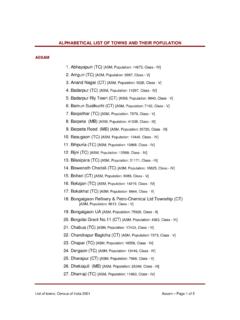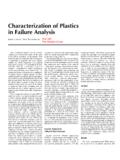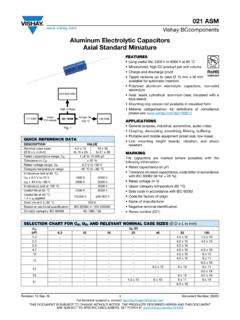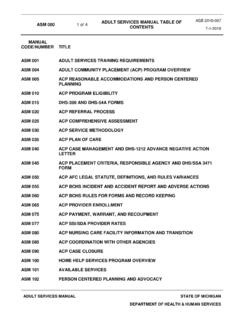Transcription of Guidelines for Assuring Quality - ASM - Australian …
1 Guidelines for Assuring Quality of Medical Microbiological Culture Media July 2012 Page 1 of 32 Guidelines for Assuring Quality of Medical Microbiological Culture Media Culture Media Special Interest Group for the Australian Society for Microbiology, Inc. 2nd edition July 2012 Guidelines for Assuring Quality of Medical Microbiological Culture Media July 2012 Page 2 of 32 FOREWORD to the First Edition The Media Quality Control Special Interest Group of the Australian Society for Microbiology was formed in 1991 by a group of interested individuals after an upsurge in interest in the issue of media Quality and the appearance that no common standards or consensus existed in this area in Australia.
2 Increased interest, especially amongst medical microbiologists, in what was being done, or should be done, by way of Assuring the Quality of microbiological media made the issue contentious. The National Association of Testing Authorities (NATA) Australia, were amongst those seeking guidance in the area of Media Quality Control, being in the position of accrediting microbiology laboratories in the fields of biological testing and medical testing. They found little in the way of consistency and knew of no locally-applicable Guidelines on which to base their assessments and recommendations. It fell upon members of the Australian Society for Microbiology, the only professional or learned society in Australia dealing specifically with issues in microbiology, to establish some Guidelines . To that end, the Media Quality Control Special Interest Group established a working party to devise a set of Guidelines and it was agreed that they should not be dissimilar in content to the standard, Quality Assurance for Commercially Prepared MicrobiologicalCulture Media, Document M22-A, published by the National Committee for Clinical Laboratory, Standards in the USA in 1990.
3 Appropriate provision should be made for the forms of microbiological media used routinely in Australia and any other local idiosyncrasies and the Guidelines should complement NATA Technical Note No. 4, Guidelines for the Quality Management of Microbiological Media, in providing specific instruction as to how testing of media should be performed. The working party has produced this document based on consensus. It is intended to offer guidance to medical microbiology laboratories of any size, whether they prepare media in-house, purchase it commercially, or obtain it from a central facility within their greater organization. To this end, some compromises have been necessary. The document seeks to give specific direction in key areas, however it is recognised that considerable variability exists in the resources to which different laboratories have access, and hence options and alternatives are offered.
4 It is intended that selections be made from alternatives with every consideration given to the practice of good science, and that alternative approaches not covered specifically by these Guidelines must be subjected to studies in the laboratory applying them in order to validate their effectiveness and consistency in reaching the desired outcome. The over-riding aim of generating Guidelines such as these is to promote a consistently high standard of Quality in the performance of microbiology in Australia. Major contributors to the First Edition: Michael Arghyros Garry Douglass Michelle L cher Philip Mugg David C. Myatt Tom Olma Alida Scholtes Irene Wilkinson Guidelines for Assuring Quality of Medical Microbiological Culture Media July 2012 Page 3 of 32 FOREWORD to the Second Edition Much has happened in the sixteen years since the first edition of these Guidelines for medical microbiological culture media were released.
5 A draft revision prepared (and in limited release) in 2001 was with the intent of incorporating medical mycological culture media. This amalgamated version of Guidelines was abandoned, after further discussion and consultation concluded that a separate set of Guidelines was more appropriate for the mycology media. Unfortunately, release of the separate mycology document was delayed longer than originally planned or intended; however, this has also allowed for further improvements to the document before its final release in 2012 (1). In 2000 the Culture Media Special Interest Group (SIG) began collaboration with the Mycobacteria SIG to produce a separate document for Assuring Quality of solid media used in Australia for cultivation of medically important mycobacteria, and resulted in the release of Guidelines in 2004. A second edition of the mycobacteria Guidelines have now been released in 2012 (2).
6 Through 2002 to 2004, the Culture Media SIG also worked on producing a new set of Guidelines for Assuring Quality of food and water microbiological culture media, and the Guidelines were released in 2004. These filled a significant gap, and were also cited as the basis for converting the existing International Standards Organisation (ISO) technical specifications for Quality control of culture media used in food microbiology (3), to a full ISO Standard that also incorporates media used in water microbiology (4). The Food and Water Guidelines have been revised and a second edition released in 2012 (5). This new edition of the Guidelines for medical microbiological culture media aims to capture and reflect those changes that have occurred since the first edition, and to re-invigorate the document s relevance in Quality control and Quality assurance of medical microbiological culture media.
7 This has resulted in an expanded, larger document than previously existed. In circumstances not covered by these Guidelines , well-documented in-house procedures that deal with Assuring Quality (in those circumstances) should be applied. For matters pertaining to Assuring Quality of medical mycological culture media, and to solid mycobacteria media used in Australia, please refer to the Guidelines produced for those topics (1, 2). Peter Traynor, National Convenor, Culture Media Special Interest Group, Australian Society for Microbiology, Inc. Any suggestions for amendments or changes, questions arising, should be directed to the National Convenor of the SIG via email. Please send to Please include as the Subject Line: Medical Microbiological Media - QC Guidelines 2012 Attention: Culture Media SIG Convenor Please include as much detail as you can in the body of the email.
8 Acknowledgement of receipt of your email will be made. Any amendments agreed to by the Special Interest Group Convenors will be carried forward to be included in the next edition. Any suggested amendments that are not accepted, or questions arising, will be included as a supplementary Q&A in the next edition, including an explanatory response. Guidelines for Assuring Quality of Medical Microbiological Culture Media July 2012 Page 4 of 32 TABLE OF CONTENTS Foreword to the First Edition Foreword to the Second Edition Introduction Application Scope Definitions Media Manufacturer Quality Assurance Practices Requirements Contamination and Significant Physical Imperfections Control strains of Bacteria Maintenance of Cultures used for Quality Control Testing Test Procedures for Culture Media Parameters to be Measured in Test Procedures Productivity Selectivity
9 Specificity Growth Recovery of Control Microorganisms Quantitative recovery Non-selective solid media selective solid media non-selective liquid media selective liquid media Qualitative recovery Non-selective solid media selective solid media non-selective liquid media selective liquid media Interpretation of Results Interpretation of Quantitative Recovery Results Interpretation of Qualitative Recovery Results Reporting Quality Assurance Data to Users Packaging.
10 Transport and Storage Shelf Life of Prepared Media User Quality Assurance Practices General Requirements Physical Inspection of Plates/Tubes/Bottles Remedial Action for Deficiencies Observed Performance Monitoring References Appendix A: Recommended control strains & acceptance criteria for growth performance testing of medical microbiological culture media Appendix B: Sterility Sampling Plan based on ISO 11133-2: 2003, AS1199-2003 (ISO2859-1:1999), & explanatory notes. Guidelines for Assuring Quality of Medical Microbiological Culture Media July 2012 Page 5 of 32 Introduction As emphasized by the National Association of Testing Authorities Australia (NATA), each testing laboratory is responsible for ensuring that an appropriate level of Quality assurance (QA) is performed on the media it uses, whether derived from in-house or commercial sources and this needs to be fully documented (6, 7).






